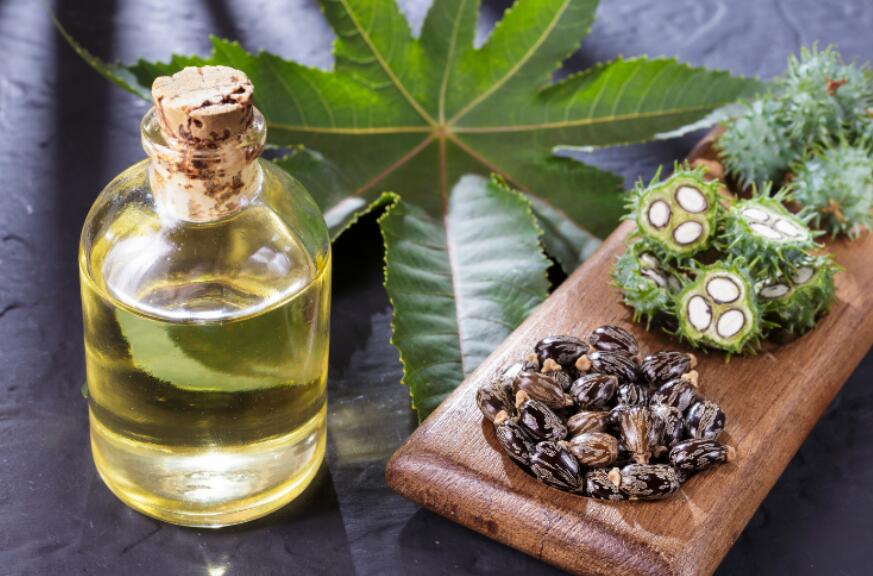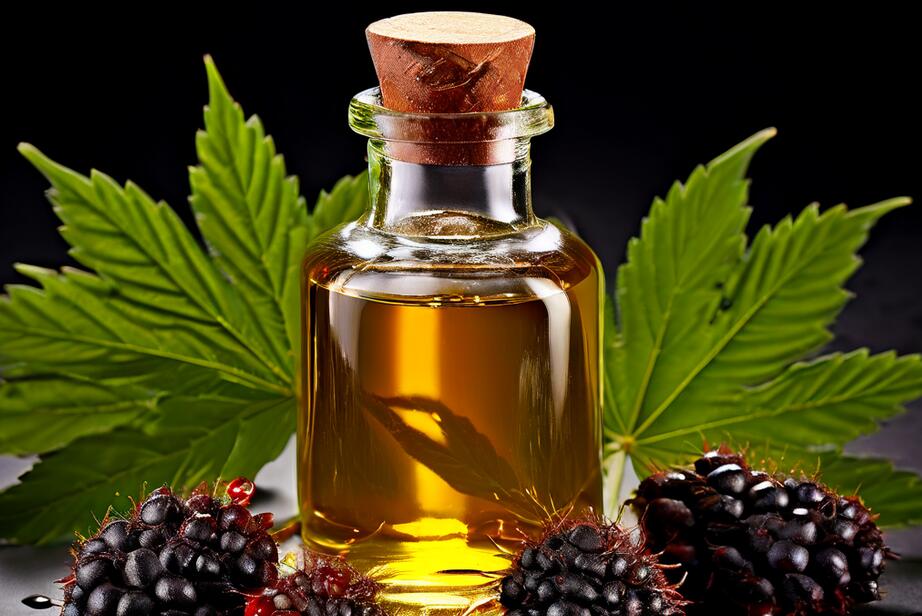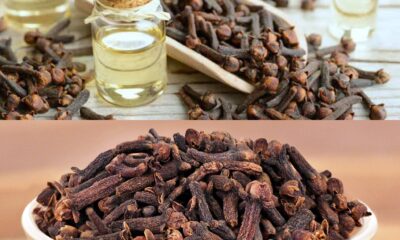IN-THE-NEWS
Castor Oil Benefits, Uses, Side Effects and Precautions
Published
8 months agoon
By
1oo9t
Have you ever stumbled upon a natural remedy that seems to do it all? Enter castor oil, a powerhouse derived from the seeds of the Ricinus communis plant. It is a thick, viscous liquid with a pale yellow color. Castor oil has been used for centuries for its medicinal and cosmetic properties. With its rich composition of ricinoleic acid, castor oil offers solutions for everything from stubborn constipation to dry skin and even promotes luscious hair growth. In this article, we will explore 18 amazing benefits and uses of castor oil. In addition, we will also discuss how to use it effectively…Click Here To Continue Reading>> …Click Here To Continue Reading>>
Nutritional Profile of Castor Oil
According to MyFitnessPal, one tablespoon (13.6 grams) of castor oil contains:
- Calories: 120
- Protein: 0 grams
- Fat: 14 grams
- Carbohydrates: 0 grams
- Fiber: 0 grams
- Sugar: 0 grams
Castor oil is also a good source of vitamin E and contains small amounts of omega-6 and omega-9 fatty acids.
Common Types of Castor Oils
There are several common types of castor oils available, each with its unique characteristics and applications. Here are some of the most popular varieties:
1. Regular Castor Oil
Regular castor oil, also known as yellow or clear castor oil, is the most common type. It is produced by cold-pressing the castor beans without any roasting or chemical treatment. This results in a pale yellow to clear oil that is highly versatile and suitable for various applications, including hair and skin care, and internal use as a laxative.
2. Jamaican Black Castor Oil (JBCO)
Jamaican Black Castor Oil is a variant of castor oil that is popular for hair care. It is produced by roasting the castor beans, which gives the oil a dark brown to black color and a distinctive smoky aroma.
The roasting process also introduces ash into the oil, resulting in a higher pH level compared to regular castor oil. JBCO is believed to have more clarifying properties and is particularly effective for promoting hair growth and improving scalp health.
3. Cold-Pressed Castor Oil
Cold-pressed castor oil is produced by pressing the castor beans at low temperatures, usually below 50°C (122°F). This method helps retain more of the oil’s natural properties and nutrients compared to regular castor oil.
This may be subjected to higher temperatures during processing. Cold-pressed castor oil is often preferred for internal use due to its purity and minimal processing.
4. Organic Castor Oil
Organic castor oil is derived from organically grown castor beans without the use of pesticides or chemicals. It is a preferred choice for those seeking a more natural and environmentally friendly option for hair and skin care.
5. Hydrogenated Castor Oil (Castor Wax)
Hydrogenated castor oil, also known as castor wax, is produced by hydrogenating regular castor oil. This process hardens the oil, making it more suitable for use in cosmetics, candles, and other applications that require a firmer consistency.
6. Sulphonated Castor Oil (Turkey Red Oil)
Sulphonated castor oil, also called Turkey Red Oil, is made by adding sulfuric acid to castor oil. It was the first synthetic detergent after ordinary soap and is used in formulating lubricants, softeners, and dyeing assistants.

18 Amazing Castor Oil Benefits and Uses
1. Natural Laxative
Castor oil is best known for its effectiveness as a natural laxative. The FDA has approved it for this purpose, particularly for relieving temporary constipation. Ricinoleic acid stimulates the intestines, promoting bowel movements.
A study published in the Journal of Gastroenterology highlighted its efficacy in inducing bowel movements within a few hours of ingestion. This makes it a popular choice for those seeking quick relief from constipation.
While effective, castor oil should not be used for prolonged periods. Overuse can lead to cramping, diarrhea, and dehydration. It is essential to consult a healthcare professional before using castor oil for constipation, especially for people with gastrointestinal disorders.
To use it effectively:
- Dosage: Take 1 to 2 tablespoons (15-30 mL) of castor oil on an empty stomach. It’s advisable to mix it with juice to improve the taste.
- Timing: Expect results within 6 to 12 hours. Do not use castor oil for more than 7 consecutive days without consulting a healthcare professional.
2. Anti-Inflammatory Properties
The anti-inflammatory effects of castor oil are attributed to its high ricinoleic acid content. Research indicates that this fatty acid can reduce inflammation when applied topically. A study published in Phytotherapy Research found that castor oil was as effective as non-steroidal anti-inflammatory drugs (NSAIDs) in alleviating knee arthritis symptoms.
To harness its anti-inflammatory benefits, castor oil can be massaged into sore joints or muscles. This can help reduce pain and swelling associated with conditions like arthritis or muscle strains.
Additionally, castor oil can be used in a warm compress to enhance its soothing effects. For best results, apply castor oil to the affected area and cover with a warm cloth for 20-30 minutes.
3. Wound Healing
Castor oil’s antibacterial and antimicrobial properties aid in wound healing. It creates a moist environment that promotes faster healing and prevents infection. A clinical study showed that castor oil, when combined with other ingredients, significantly improved wound healing rates compared to traditional treatments.
For minor cuts and abrasions, castor oil can be applied directly to the affected area. However, it is advisable to consult a healthcare professional for more severe wounds.
Additionally, using castor oil in conjunction with a sterile bandage can provide added protection and moisture. For optimal results, apply castor oil to the wound and cover with a clean dressing, changing it daily.
4. Moisturizer for Skin
Rich in fatty acids, castor oil is an excellent natural moisturizer. It penetrates deeply into the skin, providing hydration and improving skin texture. Its emollient properties make it suitable for treating dry skin conditions, such as eczema and psoriasis.
A study in the International Journal of Cosmetic Science demonstrated that castor oil effectively improved skin hydration levels, making it a valuable addition to skincare routines.
Its ability to lock in moisture is particularly beneficial during dry winter months or in arid climates. Castor oil can be used as a standalone moisturizer or incorporated into homemade skincare products.
5. Acne Treatment
Castor oil’s antibacterial properties can help combat acne by reducing the growth of acne-causing bacteria. Its anti-inflammatory effects also soothe irritated skin. While anecdotal evidence supports its use for acne treatment, more research is needed to establish its effectiveness conclusively.
To use castor oil for acne, it can be applied directly to affected areas or mixed with other oils for a more balanced formulation. A patch test is recommended to ensure no allergic reactions occur.
For best results, you can apply castor oil at night to allow it to work while you sleep. Gently massage the oil into the skin and leave it on overnight before washing it off in the morning.
6. Hair Growth Stimulant
Many people use castor oil to promote hair growth and improve scalp health. Its moisturizing properties can help reduce dryness and flakiness, creating a healthier environment for hair growth. Some studies suggest that the ricinoleic acid in castor oil may enhance circulation to the scalp, promoting hair growth.
For best results, castor oil can be massaged into the scalp and left on for a few hours or overnight before washing it out. Regular application may yield noticeable improvements in hair thickness and overall health.
Additionally, combining castor oil with essential oils like rosemary or peppermint can enhance its effectiveness. To use, mix a few drops of essential oil with castor oil before applying it to the scalp.

7. Treatment for Dandruff
Castor oil can help alleviate dandruff due to its moisturizing and antifungal properties. It can soothe the scalp and reduce flakiness, making it a popular choice for those struggling with dandruff.
To treat dandruff, apply castor oil to the scalp, leave it on for at least 30 minutes, and then wash it out with a gentle shampoo. Regular use can help maintain a healthy scalp. Mixing castor oil with tea tree oil can provide additional antifungal benefits.
For a deep treatment, apply castor oil to the scalp, cover it with a shower cap, and leave it on overnight before washing it out in the morning.
8. Natural Remedy for Stretch Marks
The moisturizing properties of castor oil make it effective in reducing the appearance of stretch marks. Its ability to penetrate the skin helps improve elasticity and promote healing.
For best results, apply castor oil to the affected areas daily, massaging it gently into the skin. Consistent use over time may help diminish the appearance of stretch marks.
You can also combine castor oil with vitamin E oil can further enhance its benefits. Gently massage the oil into the skin using circular motions to improve absorption. READ FULL STORY HERE>>>CLICK HERE TO CONTINUE READING>>>
9. Relief from Menstrual Cramps
Castor oil has been traditionally used to relieve menstrual cramps. Its anti-inflammatory properties can help reduce pain and discomfort associated with menstruation.
Applying a warm castor oil pack to the abdomen can provide soothing relief. This method combines the benefits of heat and the oil’s therapeutic properties for enhanced comfort.
Additionally, taking a warm bath with castor oil can also help alleviate cramps. For a castor oil pack, soak a clean cloth in the oil, place it on the lower abdomen, and cover it with a heating pad or hot water bottle for 30-60 minutes.
10. Boosts Immune Function
Castor oil is believed to enhance immune function by promoting lymphatic drainage. A study found that castor oil packs increased lymphocyte production, which plays a crucial role in the body’s immune response.
Using castor oil packs on the abdomen can support immune health and improve overall well-being. These packs can be made by soaking a cloth in castor oil and applying it to the skin, often with a heat source for added benefit. For optimal results, use castor oil packs for 30-60 minutes, 2-3 times per week.
11. Improves Circulation
The application of castor oil can improve blood circulation. Enhanced circulation supports overall health and can aid in the recovery of injuries.
Ricinoleic acid promotes vasodilation, which can increase blood flow to the applied area. This property makes castor oil beneficial for sore muscles and joint pain.
Regularly massaging castor oil into the skin can help maintain healthy circulation. Focus on areas with poor circulation, such as the feet and legs, for best results.
12. Laxative for Colon Cleansing
Castor oil is often used in preparation for medical procedures, such as colonoscopies, due to its effective laxative properties. It helps cleanse the colon by inducing bowel movements.
In medical settings, castor oil may be administered under supervision to ensure safety and efficacy during bowel preparation. It is essential to follow medical advice when using castor oil for this purpose. Proper dosage and timing are crucial for effective colon cleansing.
13. Antifungal Properties
Castor oil has demonstrated antifungal activity against various fungi, including those responsible for skin infections. The undecylenic acid in castor oil is particularly effective against fungal infections like athlete’s foot and nail fungus.
For treating fungal infections, castor oil can be applied directly to the affected area. Regular application may help eliminate the infection over time. Combining castor oil with other antifungal agents can enhance its effectiveness. For nail fungus, apply castor oil to the affected nail and cover with a bandage overnight.
14. Natural Lip Balm
Castor oil is an excellent natural remedy for dry, chapped lips. Its moisturizing properties help hydrate and protect the delicate skin of the lips.
Apply castor oil directly to the lips as needed, or mix it with other natural ingredients like beeswax for a homemade lip balm. This can provide long-lasting hydration and protection against environmental factors. For added flavor and scent, consider adding a few drops of peppermint or vanilla essential oil to your lip balm mixture.

15. Soothes Sunburn
The anti-inflammatory properties of castor oil can help soothe sunburned skin. It provides hydration and relief from pain and redness.
To relieve sunburn, apply castor oil to the affected area and allow it to absorb into the skin. This can help reduce discomfort and promote healing. Mixing castor oil with aloe vera gel can enhance its soothing effects. For best results, apply the mixture to sunburned skin and cover with a cool, damp cloth for 15-20 minutes.
16. Supports Healthy Skin Aging
Castor oil may help reduce the appearance of fine lines and wrinkles due to its moisturizing and antioxidant properties. Its ability to hydrate the skin can promote a youthful appearance.
Incorporating castor oil into your skincare routine can help maintain skin elasticity and hydration, potentially slowing the aging process. Applying castor oil as a nighttime treatment can allow it to work while you sleep. For an extra boost, mix castor oil with a few drops of vitamin E oil before applying it to the skin.
17. Relieves Dry Eyes
Some people use castor oil as a natural remedy for dry eyes. Its lubricating properties can provide relief from discomfort associated with dry eye syndrome.
While some individuals find relief using castor oil for dry eyes, it is essential to consult an eye care professional before using it to avoid potential complications.
You can using specially formulated eye drops may be a safer alternative. If using castor oil for dry eyes, apply a small amount to a clean finger and gently massage it onto the eyelid.
18. Acts as a Natural Detangler
Castor oil can be used as a natural detangler for hair. Its moisturizing properties help reduce frizz and make hair more manageable.
Apply a small amount of castor oil to damp hair, focusing on the ends. This can help smooth out tangles and promote shine.
For added benefits, you can also consider mixing castor oil with a lightweight carrier oil, such as jojoba or argan oil. Apply the mixture to the hair, focusing on the ends, and comb through with a wide-tooth comb to detangle.

Potential Side Effects of castor oil
While castor oil is generally safe for most people when used appropriately, it can cause side effects, particularly when ingested. Here are some potential side effects and precautions to consider:
- Gastrointestinal Distress: Common side effects of oral castor oil consumption include nausea, vomiting, diarrhea, and abdominal cramps. These symptoms are often a result of the oil’s strong laxative effect.
- Dehydration: Due to its potent laxative properties, excessive use of castor oil can lead to dehydration, especially if fluid intake is not adequately maintained.
- Electrolyte Imbalances: Prolonged use or high doses of castor oil may result in electrolyte imbalances. This can affect heart and muscle function.
- Allergic Reactions: Some individuals may experience allergic reactions to castor oil, including skin rashes, itching, or swelling.
- Abdominal Pain: Using castor oil without a clear medical indication can lead to abdominal pain, particularly if there is an underlying condition.
Precautions When Using Castor Oil
1. Pregnancy and Labor Induction
Castor oil is known to stimulate uterine contractions and has been used historically to induce labor. Pregnant individuals should avoid using castor oil unless specifically advised by a healthcare provider, as it can lead to premature labor and other complications.
2. Pre-existing Medical Conditions
Individuals with certain medical conditions should avoid using castor oil, including:
- Gastrointestinal Disorders: Those with conditions such as appendicitis, gastrointestinal obstruction, or inflammatory bowel disease (IBD) should avoid castor oil. This can increase the risk of exacerbating their conditions.
- Severe Abdominal Pain: If experiencing unexplained abdominal pain, it is crucial to consult a healthcare professional before using castor oil, as it may mask underlying issues.
3. Drug Interactions
While castor oil does not have widely reported drug interactions, it is essential to inform healthcare providers of all medications being taken. This is particularly important for individuals using other laxatives, as combining them with castor oil can increase the risk of adverse effects.
FAQs
1. Is castor oil safe to ingest?
Castor oil is generally considered safe to ingest in moderation, particularly for relieving constipation. However, it is essential to follow dosage guidelines and consult a healthcare professional before use, especially for children, pregnant women, and individuals with pre-existing medical conditions.
2. How long does it take for castor oil to work as a laxative?
Castor oil typically induces bowel movements within 2-6 hours of ingestion. However, the onset time can vary depending on the individual’s sensitivity and the dosage taken.
3. Can castor oil be used as a natural sunscreen?
A: Castor oil provides a mild level of sun protection, with an estimated SPF of 4-5. However, it should not be used as a substitute for traditional sunscreens, as it does not provide adequate protection against harmful UV rays. It can be used in conjunction with other sun protection measures.
4. How often should castor oil be applied to the skin?
The frequency of application depends on the specific use. For moisturizing purposes, castor oil can be applied daily or as needed. For treating specific conditions like acne or fungal infections, it may be applied 1-2 times per day. Always follow the recommended usage guidelines or consult a healthcare professional.
5. Is castor oil safe for use around the eyes?
No, castor oil should not be applied directly to the eyes or the delicate skin around the eyes. It can cause irritation, pain, and blurred vision. If accidental contact occurs, rinse the affected area thoroughly with water.
6. How should I store castor oil?
To maintain the quality and effectiveness of castor oil, it should be stored in a cool, dark place away from direct sunlight and heat sources. Keeping it in a tightly sealed container will help prevent oxidation and extend its shelf life.
Ideally, castor oil should be stored in a glass bottle, as plastic containers can sometimes leach chemicals into the oil. When stored properly, castor oil can last for up to 1-2 years. Always check for any changes in color, smell, or consistency before use, as these may indicate that the oil has gone bad.
Related
You may like
IN-THE-NEWS
14 Healthy Drinks That Make You Poop Immediately
Published
2 months agoon
February 24, 2025By
1oo9t
Let’s be real – constipation is one of those awkward, uncomfortable issues that no one really wants to talk about. But the truth is, it affects millions of people, and it’s nothing to be ashamed about. But, do you know there are plenty of natural, healthy ways to get your digestive system back on track? These amazing drinks can help stimulate bowel movements and have you feeling light, and refreshed.
Now, I know what you’re thinking – “Ew, laxatives? No thanks!” But trust me, these drinks are nothing like those harsh, unpleasant medications. In fact, many of them are quite delicious. So if you’re tired of straining, struggling, and feeling bloated, give some of these a try. Your digestive system will thank you…Click Here To Continue Reading>> …Click Here To Continue Reading>> READ FULL STORY HERE>>>CLICK HERE TO CONTINUE READING>>>
Related
IN-THE-NEWS
Biden Walks Away Without Taking Any Questions About New Orleans Terror Attack After Remarks at Camp David (Video) –
Published
4 months agoon
January 3, 2025By
1oo9t
Joe Biden addressed the nation from Camp David, the presidential retreat in Catoctin Mountain Park in Maryland on Wednesday evening following a terrorist attack that left at least 15 people dead in New Orleans.
At least 15 people were killed, 35 injured after a terrorist identified as 42-year-old Shamsud Din Jabbar plowed through a crowd in New Orleans during the New Year’s Eve celebration.
According to law enforcement, Jabbar did not work alone and was part of a larger network of terrorists…Click Here To Continue Reading>> …Click Here To Continue Reading>>
Earlier Wednesday Joe Biden stopped to chat with reporters as he departed Wilmington, Delaware for Camp David on Wednesday for another vacation.
He provided an absolutely worthless statement on the terrorist attack
“You all got my statement. I’ll have more to say in next hour about what’s going on in New Orleans…I’ve spoken to every member of the agencies, from CIA to national security team to FBI and NSC…anger and frustration,” Biden said.
WATCH:
On Wednesday evening, Biden’s handlers shot him up with his latest meth cocktail and pushed out in front of a camera to address the nation READ FULL STORY HERE>>>CLICK HERE TO CONTINUE READING>>>
Biden slurred through prepared remarks.
“Hours before, he posted videos on social media indicating that he is inspired by ISIS, expressing a desire to kill,” Biden said.
WATCH:
Biden didn’t take any questions about the terror attack. He shuffled away from the lectern and disappeared.
WATCH:
Related
IN-THE-NEWS
Biden Announces Liz Cheney to Receive Presidential Citizens Medal, The Reason Will Shock You –
Published
4 months agoon
January 3, 2025By
1oo9t
President Joe Biden will formally announce recipients of the Presidential Thursday at 5 PM, and one name on the list is sure to raise eyebrows: Liz Cheney. The former Republican member of Congress — and vocal critic of President-elect Donald Trump — is among the 20 names in a statement released early Thursday morning.
The Presidential Citizens Medal is awarded to citizens of the United States of America who have performed exemplary deeds of service for their country or their fellow citizens. President Biden believes these Americans are bonded by their common decency and commitment to serving others. The country is better because of their dedication and sacrifice…Click Here To Continue Reading>> …Click Here To Continue Reading>>
The White House statement lauds Cheney: “Throughout two decades in public service, including as a Congresswoman for Wyoming and Vice Chair of the Committee on the January 6 attack, Liz Cheney has raised her voice—and reached across the aisle—to defend our Nation and the ideals we stand for: Freedom. Dignity. And decency. Her integrity and intrepidness remind us all what is possible if we work together.”
The awards will be presented at the White House on January 2, 2025. The following individuals will be awarded the Presidential Citizens Medal:
Mary L. Bonauto — Attorney and activist Mary Bonauto first fought to legalize same-sex marriage in Vermont, Massachusetts, Connecticut, and Maine before arguing before the Supreme Court in Obergefell v. Hodges, which established marriage equality as the law of the land. Her efforts made millions of families whole and forged a more perfect Union.
Bill Bradley — Raised in small-town Missouri, Bill Bradley showed a dedication to basketball that would define his courage, discipline, and selflessness. A two-time NBA Champion and Hall-of-Fame New York Knick, he served three terms as a United States Senator from New Jersey and was a candidate for president, advancing tax reform, water rights, civil rights, and more, while still today seeking to deepen our common humanity with humility and heart.
Frank K. Butler, Jr. — As a pioneering innovator, Navy Seal, and leader in dive medicine, Dr. Frank Butler introduced Tactical Combat Casualty Care to the medical world that set new standards for tourniquet use not only for injuries in war, but injuries across daily civilian life. He has transformed battlefield trauma care for the United States military and saved countless lives.
Elizabeth L. Cheney — Throughout two decades in public service, including as a Congresswoman for Wyoming and Vice Chair of the Committee on the January 6 attack, Liz Cheney has raised her voice—and reached across the aisle—to defend our Nation and the ideals we stand for: Freedom. Dignity. And decency. Her integrity and intrepidness remind us all what is possible if we work together.
Christopher J. Dodd — Chris Dodd has served our Nation with distinction for more than 50 years as a United States Congressman, Senator, respected lawyer, and diplomat. From advancing childcare, to reforming our financial markets, to fostering partnerships across the Western Hemisphere—he has stood watch over America as a beacon to the world.
Diane Carlson Evans —After serving as an Army nurse during the Vietnam War, Diane Carlson Evans founded the Vietnam Women’s Memorial Foundation to ensure female service members received the recognition they deserve—one of our Nation’s most sacred obligations. Her duty and devotion embody the very best of who we are as Americans.
Joseph L. Galloway (posthumous) — From Vietnam to the Persian Gulf, Joe Galloway spent decades sharing first-hand accounts of horror, humanity, and heroism in battle. Known as the soldier’s reporter and the soldier’s friend, he embedded with American troops, rescued wounded soldiers under fire, and became the only civilian awarded a Bronze Star for combat valor by the United States Army as one of the most respected war correspondents of his era.
Nancy Landon Kassebaum — The first woman to represent Kansas, Nancy Kassebaum was a force in the United States Senate. From supporting a woman’s right to choose to reforming health care, she stood up for what she believed in even if it meant standing alone, and she reached across the aisle to do what she believed was right.
Ted Kaufman — For decades, including as a United States Senator from Delaware, Ted Kaufman has served the Nation with honesty and integrity. A master of the Senate who championed everyday Americans and public servants, he’s been at the forefront of consequential debates about the courts, the financial system, and more. READ FULL STORY HERE>>>CLICK HERE TO CONTINUE READING>>>
Carolyn McCarthy — As a nurse, Carolyn McCarthy had an instinct to heal and serve. When her husband and son were shot on a local commuter train, she became an advocate so persuasive that she was recruited to run for Congress. She served 18 years, championing gun safety measures including improved background checks, as a citizen legislator devoted to protecting our Nation’s welfare.
Louis Lorenzo Redding (posthumous) — A groundbreaking civil rights advocate, Louis was the first Black attorney admitted to the bar in Delaware, where he argued against segregation in the seminal cases of Bulah v. Gebhart and Belton v. Gebhart—laying the legal framework for Brown v. Board of Education. A towering figure and a generous mentor, he opened doors of equity and opportunity for all Americans.
Bobby Sager — A Boston native, Bobby Sager travels the world as a photographer and philanthropist grounded in family and empathy, wielding his camera and influence to connect with people in war-torn countries, capture their hope and humanity, and inspire others to take action and see a fuller portrait of the planet we all share.
Collins J. Seitz (posthumous) —As a state judge in Delaware, Judge Seitz became the first judge in America to integrate a white public school, dismantling the doctrine of “separate but equal” with exacting detail and reverence for the equal protection clause of the 14th Amendment of our Constitution. His brave ruling tore down walls of separation to help us see each other as fellow Americans.
Eleanor Smeal — From leading massive protests and galvanizing women’s votes in the 1970s to steering progress for equal pay and helping the Violence Against Women Act become law, Ellie Smeal forced the Nation to not only include women in political discourse but to value them as power brokers and equals. Her strategic vision over more than 40 years embodies the American pursuit to create a fairer, more just world.
Bennie G. Thompson — Born and raised in a segregated Mississippi, as a college student inspired by the Civil Rights movement, Bennie Thompson volunteered on campaigns and registered southern Black voters. That call to serve eventually led him to Congress, where he chaired the House January 6th Committee—at the forefront of defending the rule of law with unwavering integrity and a steadfast commitment to truth.
Mitsuye Endo Tsutsumi (posthumous) — In a shameful chapter in our Nation’s history, Mitsuye Endo was incarcerated alongside more than 120,000 Japanese Americans. Undaunted, she challenged the injustice and reached the Supreme Court. Her resolve allowed thousands of Japanese Americans to return home and rebuild their lives, reminding us that we are a Nation that stands for freedom for all.
Thomas J. Vallely — A United States Marine during the Vietnam War, Thomas Vallely has never given up on peace. Over the course of five decades, he has brought Vietnam and the United States together—establishing Fulbright University Vietnam, fostering greater economic and cultural exchange, and overcoming the perils of the past to seize the promise of the future. His service remains a symbol of American leadership in the world.
Frances M. Visco — As president of the National Breast Cancer Coalition, Fran Visco has fought tirelessly and fearlessly to increase Federal funding for breast cancer research, early detection education, and access to women’s healthcare. As a breast cancer survivor, she turned pain into purpose, changed the landscape of breast cancer advocacy, and has become a powerful symbol of hope for the Nation.
Paula S. Wallace —A lifelong educator and trailblazer of the arts, Paula Wallace dreamt of a school that would transform how we think about professional education. By establishing the esteemed Savannah College of Art and Design and serving as its president, she has guided thousands of students into creative industries.
Evan Wolfson —By leading the marriage equality movement, Evan Wolfson helped millions of people in all 50 states win the fundamental right to love, marry, and be themselves. For 32 years, starting with a visionary law school thesis, Evan Wolfson worked with singular focus and untiring optimism to change not just the law, but society—pioneering a political playbook for change and sharing its lessons, even now, with countless causes worldwide.
Related
Trending
-

 METRO9 months ago
METRO9 months agoUnlock the Secret to Long, Luscious Locks with DIY Clove Oil
-

 METRO10 months ago
METRO10 months agoObasanjo recalls how he became Head of State after Murtala Muhammed’s assassination
-

 IN-THE-NEWS10 months ago
IN-THE-NEWS10 months agoHow Police Officers Uncovered Bandits’ Hideout, Killed Suspect In FCT
-
METRO7 months ago
Black Girl Saves Old Man from Fire. 24 Hours Later He Brings Lawyers To Her House –
-

 HEALTH & LIFESTYLE9 months ago
HEALTH & LIFESTYLE9 months ago‘I’m a neuroscientist – never do these three things, they harm your brain’
-

 METRO10 months ago
METRO10 months agoBoy who got tied to tree, set on fire gets justice thanks to last words on deathbed
-

 IN-THE-NEWS10 months ago
IN-THE-NEWS10 months agoCustoms Seizes N3bn Worth Of Cannabis Imported From Canada At Tincan Port
-

 HEALTH & LIFESTYLE7 months ago
HEALTH & LIFESTYLE7 months agoEating THIS yellow fruit can cure diseases like Constipation, Diarrhea and more; know right time to consume
